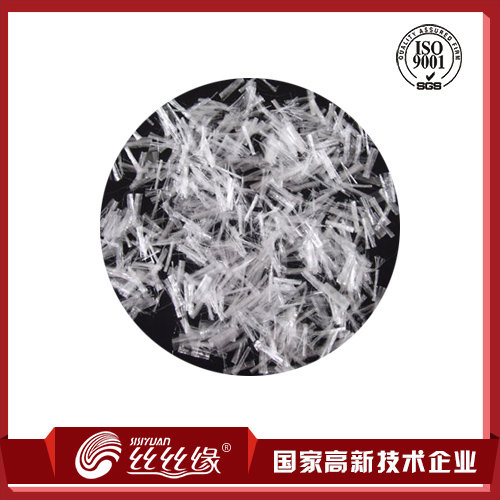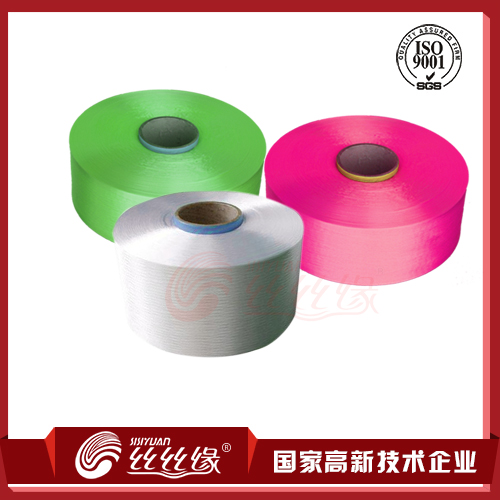
Lead:
Differential fibers generally refer to chemically modified or physically deformed chemical fibers. In the polymerization and spinning processes are modified: copolymer type, super bright type, ultra-high shrinkage, heterochromatic fast staining, antistatic type, anti-pilling, mildew, anti-bacterial, anti-fouling, Deodorant type, moisture absorption and perspiration waterproof type, fluorescence discoloration type. In the process of spinning, drawing and deformation, there are three kinds of deformation, such as blending, compound, hollow, contour, shrinkage, dissimilarity, heterochromatic, fine denier, superfine, coarse denier, coarse detail, , Mixed fiber, mixed network, mixed color, coated complex (loose bag, double bag, single bag), fuzzing and fancy yarn, yarn or fiber and other fibers are different areas. Now several of these commonly used differentiated fiber for a brief introduction.
Nylon filament
1, performance
The polyamide 6 fiber had a softening point of 180 ° C and a melting point of 215 to 220 ° C. The polyamide 66 fiber had a softening point of 235 ° C and a melting point of 245 ° C. The glass transition temperature of polyamide 6 measured by Dsc was 48 ° C and that of polyamide 66 was 50 ° C.
Polyamide fiber crystallinity, orientation and intermolecular force, high strength. General textile polyamide filament rupture strength of 4.4 ~ 5.7cN / dtex, wet strength is dry 85% to 90%. Elongation at break varies with the species, the strength of silk is lower, about 20% to 30%, ordinary filament 25% to 40%. Polyamide fiber initial modulus of 17.6 ~ 44.1cN / dtex, lower than most other fibers, easy to use during the deformation.
Polyamide fiber is the best wear resistance of all textile fibers in fiber, its wear resistance of cotton 10 times, 20 times of wool, viscose fiber 50 times.
Polyamide fibers are less hygroscopic than natural and man-made fibers, but in synthetic fibers (except for polyvinyl alcohol), their hygroscopicity is high. Polyamide 6 fiber due to the presence of monomers and low molecular weight, its moisture absorption slightly higher than polyamide 66 fiber. In the standard state, the moisture regain of polyamide 6 fiber is 3.5% ~ 5.0%, and that of polyamide 66 fiber is 3.4% ~ 3.8%.
The density of the polyamide fiber is 1.14 g / cm3, which is higher than that of the polypropylene and polyethylene fibers in all the fibers. Although the dyeing properties of polyamide fiber is less than that of natural fiber and man-made fiber, it is easy to be dyed in synthetic fiber. Generally, it can be dyed with acid dyestuff, disperse dyestuff and other dyes.
1476951307546460.jpg
2, use
The use of polyamide fiber for civilian and industrial use.
Civil, including clothing and home use, generally can be divided into woven, knitted, warp knitted fabrics and so on. Polyamide fiber can be used to make socks, underwear, shirts, sweatshirts, carpets, and can be blended with cotton, wool, viscose and other fibers, so that the fabric has good wear resistance, but also made of bedding and outdoor accessories , Furniture and other fabrics.
In industrial use, polyamide fiber is mainly used in the production of tire cord, belt, conveyor belt, fishing nets, cables, canopy sail fabric, sewing thread, filter cloth, non-woven, involving transportation, fisheries, military
Engineering and other fields.
Polypropylene filament
1, performance
The isotactic polypropylene has a glass transition temperature between about -30 ° C and 25 ° C and a melting point of from 164 ° C to 176 ° C, higher than that of polyethylene and lower than that of polyamide. At room temperature, the strength of polypropylene filament 3.1 ~ 4.5cN / dtex, breaking elongation varies by species; industrial yarn strength of 6.6 ~ 7.9cN / dtex, elongation at break of 15% to 20%. The initial modulus of the polypropylene fiber filament is 35.3-105.8 cN / dtex, which is superior to the polyamide fiber and inferior to the polyester fiber. The instantaneous resilience of the polypropylene fiber is between the polyamide fiber and the polyester fiber. When the elongation is 5%, the springback rate of the polypropylene fiber is 88% to 98%. Polypropylene fiber moisture absorption and density is the smallest of conventional synthetic fiber, the moisture regain of 0.03%, density of 0.90 ~ 0.92g / cm3. Polypropylene molecules do not contain polar groups or reactive functional groups, fiber structure and the lack of appropriate places to accommodate the dye molecules, so the polypropylene fiber dyeing is very difficult, generally made before spinning colored colored fiber.
2, use
Polypropylene fiber has a high strength, high toughness, good chemical resistance and low price and so on, so in the field of industrial and decorative applications have a wide range of uses.
Polypropylene fiber can be used for knitting, the fabric can be made underwear, ski jacket, socks and children's clothing. Polypropylene fiber and wool blended can be used to produce cold outdoor clothing, motorcycle sportswear, mountaineering suits, sailing suits and flight suits. Fine thread density Polypropylene fiber has excellent wicking effect, breathable, excellent wetting properties, close to wear to keep the skin dry, no sultry feeling, with its production of clothing than cotton clothing light 2/5, warmth is worth Wool, it can be used for knitted underwear, sportswear, swimwear, suede fabric, imitation peach fabric and imitation silk fabric. Carpet is an important field of application of polypropylene fiber, high abrasion resistance, dirt, washable polypropylene carpet is an important feature. Among the various nonwovens, the spunbond process is the fastest, while the spunbonded nonwovens are mostly polypropylene.
Textiles used in civil engineering collectively referred to as geotextiles. Polypropylene woven geotextile made of polypropylene fiber with high strength, acid and alkali resistance, anti-microbe, and wet-dry strength is the best choice for civil engineering (such as dams, reservoirs, highways and railways) built on soft soils. And so on) to reinforce the role, and to load evenly distributed so that the settlement of the roadbed evenly, reducing ground cracks.
Polypropylene fiber can also be used for decorative fabrics, carpets, canvas, bags, cigarette filters, artificial turf and medical supplies.
Acrylic filament
1, performance
Acrylic fiber is like wool, so the "artificial wool" is known, its main feature is the quality of light warm, stained bright and solid, moth, mold, sun.
Polyacrylonitrile has two glass transition temperature, 80 ~ 100 ℃ and 140 ~ 150 ℃, respectively, corresponding to the amorphous phase of the low-order and amorphous phase sequence. Polyacrylonitrile in the heating conditions neither soften nor melt, at 280 ~ 300 ℃ temperature decomposition. The stereospecific conformation of the polyacrylonitrile backbone is determined by the strong side-group cyano group (cN), which is a strong polar group. The carbon and nitrogen atoms in the cyano group are connected by a triple bond (a sigma bond and two pi bonds). This structure absorbs more photons (ultraviolet light) and can be converted into heat energy, thus protecting the primary bond. It is not prone to degradation. So the role of acrylic and sunlight on the stability of the atmosphere is very good. After a year of sunlight and atmospheric effects, most of the fiber loss of the original strength of 90% to 95%, while the strength of acrylic fiber decreased by only about 20%.
The acrylic fiber has a breaking strength of 3 to 4.8 cN / dtex, an elongation at break of 12 to 20% and an initial modulus of 33.5 to 75 cN / dtex. Wool in the 2% elongation of the rebound rate of 99%. Acrylic fiber and its less, 92% to 99%. However, in the test, the elasticity of the two fibers is different, which is due to multiple cycles of wool load elasticity is better than acrylic.
Polyacrylonitrile has a high thermal stability, heated to 170 ~ 180 ℃, the fiber color should not change. Polyacrylonitrile fiber in the presence of air or oxygen conditions will be heated cyclization, the polymer color into yellow, and finally into a brown to black. At higher temperatures can be made of carbon fiber heat treatment, acrylic fiber is an important precursor of carbon fiber.
2, use
Acrylic has many excellent properties, is widely used in blended or pure spinning, made of serge, gabardine, coat, sweatshirt, sweater, blanket, velvet fabric and woolen woolen fabric.
Acrylic fiber as carbon fiber precursor, after pre-oxidation, carbonization and graphitization process made of carbon fiber, can be used for military, aerospace and other high-tech fields.
Spandex
1, performance
Spandex fiber has great flexibility, its elongation can be greater than 400%, or even as high as 800%, 500% elongation when the rebound rate of 95% to 99%. In general, spandex fiber molecular structure, the soft segment of the relative molecular mass the greater the fiber elasticity and rebound rate is higher. Polyether-type spandex elasticity and resilience than the polyester-type spandex high.
The elastic modulus of the spandex filament is 0.35 ~ 1.05cN / dtex. The elastic modulus of the spandex is small and the softness of the spandex is very good. For example, DuPont Lycra (polyether) has a modulus of elasticity of only O.11cN / dtex. Spandex density of 1 ~ 1.25g / cm3, due to the proportion of soft and hard segments and the proportion of some differences; different varieties of spandex heat resistance of large differences in most of the fibers at 95 ~ 150 ℃ for a short time storage without injury ; Spandex moisture absorption rate is generally 0.3% to 1.3%; spandex durability, that is, good fatigue resistance, in the range of 50% to 300% elongation, 220 times per minute tensile shrinkage fatigue test, spandex Resistant to alkali, and chemical solvents, but some varieties of heat-resistant alkaline poor, such as polyester-type decomposition occurs in the hot alkali occurs, the temperature is too high, Sodium hypochlorite and other bleach will make the fiber yellow, strong decline.
2, use
Spandex yarns, yarns, core-spun yarns and co-twisted yarns (spun yarns) are available for weaving elastic fabrics in textile mills (Figure 18-4).
1, spandex bare silk
Elastic spandex knitted fabric for garments and swimwear, female socks (long tube), sock portion, braid band, and the like, and a knitted fabric having a wide range of elongation, tape.
2, coated yarn
Refers to the outer cover of other varieties of filament spandex yarn. The covering yarns are divided into single layer covered yarn and double covered yarn. The elastic elongation of the covering yarn is 300-400%, and the content of the spandex is 20-25%. Compared with the spandex bare silk, covering yarn has low slip and good touch. Coated yarn is mainly used for clothing underwear, such as belts, bras, surgical knitwear, socks upper, ribbon and shoelaces and so on.
3, core blended yarn
Also known as core spinning, spandex made from other varieties of short fiber yarn wrapped (Figure 18-5). The drawn spandex yarn enters the spinning machine, and the staple fiber yarn is also drawn and twisted into the spinning machine to form a continuous core in the spun yarn center and, in a tensioned state, The core blended yarn is wound into a cylinder. Core Spinning can be made with a wide range of applications with excellent performance, style handsome knitwear and textiles.
4, together twist yarn
Also known as twist yarn, from 1 to 2 ordinary cotton yarn, yarn or nylon and spandex twisting together, often used to weave elastic labor cloth. Twisted yarns are produced on twisting machines and are usually twisted with other fibers at 2.5 to 4 times elongation.
These yarns can be used as woven fabrics, knitted fabrics (warp and weft), narrow fabrics (i.e., tape-like fabrics), and the like.
Vinylon filament
1, performance
The dry strength of ordinary filament yarn is from 2.6 to 3.5 cN / dtex, and the wet strength is from 1.9 to 2.8 cN / dtex. The dry strength of the filament is 5.3 to 10.6 cN / dtex and the wet strength is 4.4 to 9.3 cN / Dtex; and a density of 1.26 to 1.30 g / cm3.
Vinylon's main advantage is good moisture absorption, the standard state (20 ℃, RH 65%) regain 2.5% to 4.5%, is the best of conventional synthetic fiber varieties.
PVA has good corrosion resistance and resistance to sunlight, long time placed in the sea or buried in the ground, no significant decline in strength, its resistance to sunlight is better than polyamide fiber, cotton and viscose fiber.
Vinylon's main drawback is poor dyeing, on the one hand is the amount of dye is not high, on the other hand is not bright color. This is because the fibers have a core-sheath structure and a portion of the hydroxyl groups after the acetalization is blocked. Secondly, vinylon slightly worse heat-resistant water in the wet state when the temperature exceeds 110 ~ 115 ℃, will occur significant shrinkage and deformation. PVA fabric placed in boiling water for 2 ~ 4h, part of the dissolved.
2, use
Velon filament performance and appearance and natural silk is very similar, you can weave silk fabric. However, the flexibility of vinylon poor, not easy to stain, it is generally not used for high-level clothing. With the development of polyvinyl acetal fiber production, it is in the industrial, agricultural, fisheries and other applications increasingly. One of the important uses is vinylon reinforcement material, mainly for two aspects, one plastic enhancement, and second, cement, asbestos and ceramic reinforced. Vinylon fiber can also be used for fishing nets, cables, canvas, cord and packaging materials.
Viscose fiber
1, performance
Viscose fiber in the main component, that is, cellulose, is widely present in nature, oil can not be compared to renewable major natural resources. Because of its raw materials are wood pulp, cotton linter and other natural resources, it is biodegradable, in the environment is not accumulated, no gas after combustion occurs, is extremely beneficial to the resource environment fiber material. More and more people pay attention to the sustainable development of today, such as viscose fibers such as recycled fiber more and more attention.
Viscose fiber has many excellent properties, its outstanding advantages are: excellent moisture absorption, in the standard state (20 ℃, RH 65%), viscose fiber moisture regain of 12% to 14%, second only to wool (14% (6% ~ 7%); good dyeing, viscose fiber and cotton similar to the use of direct dyes, sulfur dyes, reactive dyes and other dye dyes, chromatography complete, solid color, colorful; Because the cellulose fiber is not thermoplastic, when the temperature rises, the same soft, no adhesion; when the temperature from 20 ℃ to 100 ℃ when its strength no significant change in the temperature, 140 ~ 150 ℃ when the strength began to decline at 260 ~ 300 ℃ when the color decomposition; cellulose macromolecules on the hydroxyl prone to a variety of chemical reactions, therefore, can be grafted and other methods to modify the viscose fiber to improve the viscosity Rubber fiber performance, and produce a variety of special-purpose fiber. The disadvantage of viscose fiber is poor dimensional stability, low wet strength.
2, use
1, civilian
Viscose fiber can be pure spinning, but also with cotton, wool, linen, silk and a variety of synthetic fibers blended or intertwined, the fabric texture soft, smooth feel, good ventilation, comfortable, dyed colorful, Underwear, coat and all kinds of decorative materials. In addition, it is also widely used in non-woven fabrics.
Viscose fiber with conventional synthetic fibers (polyester, nylon, polypropylene, etc.) mixed, the fabric not only has the characteristics of synthetic fiber fabrics, synthetic fabrics and improve the comfort and hygiene, and to a certain extent, improved the textile Processability.
2, industry and other applications
Viscose fiber strength of high strength silk, heat resistance, low prices, in the tire, pressure hose, conveyor belt, canvas, coated fabrics have a wide range of applications.
Viscose fiber at 3000 ℃ carbonation can be obtained high-strength high-modulus carbon fiber, aerospace, military and many high-tech fields important reinforcement.
Hemostatic fibers made of viscose fiber, gauze, bandage and medical bed sheets, clothing, etc., in the medical and health sector has a wide range of uses.
PBT fibers
1, performance
PBT and PET are the same polyester polymer. Compared with PET, PBT macromolecules based on the flexible part of the chain longer, and thus lower melting point, but the flexibility and flexibility of macromolecular chain increased. If the elastic recovery rate of PBT is 100%, nylon (PA) is only 70%; PET was 55%. In addition, compared with PET, PBT staining without dye carrier to boiling; compared with nylon, nylon and yellow chlorine can improve the shortcomings of intolerance.
The PBT macromolecular chain has an ester group and a benzene ring structure, which imparts excellent elastic recovery and strength, as well as color fastness, light resistance, heat resistance, chemical resistance and dimensional stability similar to those of polyester s reason.
Because PBT molecular chain length and Young's modulus and PA6 similar, so the fiber is easy to micro-curl, and the crimp molecules can move more freely. This results in an excellent compression elasticity and tensile elasticity of the textured yarn and the woven fabric.
In the crystal structure of PBT fiber, the β-type crystal variants with crystal variants, color elongation heat treatment and molecular chain elongation are heat-treated by color relaxation, and molecular chains become α-crystal variants. Since this variant is also prone to occur at room temperature, the heat-setting properties of the PBT fibers are not so good and the dimensional stability of the woven fabric is inferior to that of PET fibers.
PBT fiber strength than PET fiber and PA fiber is low, Young's modulus (about 300kg / mm2) and PA6 fiber similar to the elongation elastic recovery rate at 3% elongation of 99%, elongation of 10% 80%, and PA6 fiber the same. Better crimp characteristics than the PET and PA6 good, smaller than the PA6 curl, and good elasticity.
PBT fiber has easy dyeability, the use of disperse dyes, the suction rate of about 75% rate, better than the PET fiber; but fastness, light yellow, wet pollution, such as PET fiber performance.
2, use
PBT fiber has good elasticity and dispersion of dye atmospheric pressure boiling dye, while maintaining the polyester can be washed with wear, crisp and dimensional stability, elasticity between spandex and nylon. PBT filaments modified by means of blending, copolymerization and compounding can further improve the performance and reduce the cost. It is mainly used for processing silk fabrics, dyed fabrics, warp knitted fabrics and decorative fabrics; high elastic yarn for the production of sportswear, elastic bandages, hosiery and elastic labor cloth.
Cationic dyeable polyester filament
1, performance
Polyester with high modulus, high strength, flexibility, good shape retention, and not easy to wrinkle, etc., is an ideal textile materials. Because the polyester macromolecules lack of functional groups with direct dyes, acid dyes, basic dyes and other functional groups, although with disperse dyes to form hydrogen bonds ester, but the high degree of crystallinity of polyester, the structure is tight, dye molecules difficult to enter the fiber Internal, so that dyeing difficult, monotonous color. To this end, a strongly acidic acidic sulfonic acid group or a less acidic phosphate group compound is copolymerized with PET to obtain a good cationic dyeable copolyester (CDP). By chemical modification can be used with cationic dyes under normal pressure or pressure dyeing polyester called cationic dyeable polyester.
2, use
Cationic dyed polyester filament and acrylic, regular polyester, wool, viscose blended intertwined one bath dyeing (with bath dyeing), can achieve the blank, the depth of color and other special effects. Product style is unique, more sensitive varieties, apply to wool, yarn-dyed, knitting, silk and other industries.
Shaped filament
1, performance
With the continuous development of new varieties of polyester filament and its filament, the development of profiled filament broad prospects. Shaped filament is a special-shaped spinning hole spinning non-circular cross-section of the filament, the fiber cross-sectional area is equal, the special-shaped filament than the circular filament has greater bending stiffness, the anti-fiber Spherical good, good elasticity; and the surface of the longitudinal convex and weaving, fiber cohesion increased, and has a special luster. The trilobal filament has a cross section similar to that of silk, and its longitudinal surface reflects the light plane, giving the fabric a specific metallic luster. Six leaves, eight leaf-shaped silk because of the scattered light reflection, it can play extinction effect. In general, as long as the special-shaped spinneret meet the requirements of the production, shaped polyester filament spinning, post-processing technology is not difficult.
2, use
According to the different varieties and cross-sectional shape, mainly used for (1) satin-type fabric and crepe-type fabric, the production of high-end women's clothing. (2) silk fabric, such as georgette yarn wrinkle, faction Secretary, poplin and so on. (3) wool fabric. (4) hemp-type fabric. (5) similar to the antelope wool, rabbit hair, mohair and other special animal fiber products.







